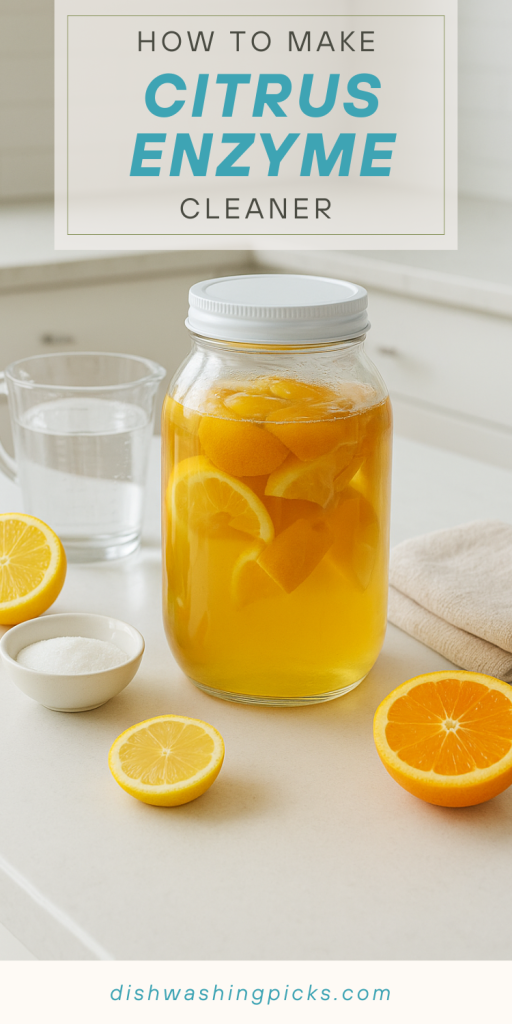
The Secret in Your Orange Peels
Ever peel an orange and think, “Wow, that smells clean and fresh”? Well, what if I told you those very peels could turn into a powerful cleaner? Yep, instead of throwing them away, you can actually brew up something called citrus enzyme cleaner—a natural, multi-purpose cleaning solution that works wonders around the house.
It’s like alchemy for the everyday person: a little fruit waste, some sugar, a splash of water, and time. The result? A bubbly, slightly tangy, eco-friendly cleaner that can rival store-bought sprays without the harsh chemicals.
What Is Citrus Enzyme Cleaner (and Why Should You Care)?
Okay, so “enzyme cleaner” might sound a bit science-y, but don’t worry—you don’t need a lab coat for this. Here’s the breakdown:
- The science-y bit: Enzymes are natural proteins that speed up the breakdown of dirt, grease, and even odors. When fruit peels ferment with sugar and water, they release these enzymes.
- The eco-friendly win: You’re reusing fruit scraps instead of tossing them, which means less waste.
- The money saver: A bottle of enzyme cleaner from the store can cost you, but homemade? Basically free.
Think of it as turning kitchen scraps into cleaning gold.
What You’ll Need (Spoiler: Not Much)
Grab these basics before you start:
- 2 cups citrus peels (orange, lemon, lime, grapefruit—mix them if you like)
- ½ cup brown sugar (white sugar works too, but brown speeds fermentation)
- 1 liter water
- A large plastic bottle or jar with a loose-fitting lid
- Patience (yep, this one takes time to ferment)
Quick tip: Don’t use glass jars with airtight lids for this process—fermentation builds pressure, and nobody wants an accidental kitchen explosion.
How to Make It: The Step-by-Step Guide
Here’s the fun part:
- Mix ingredients. Combine citrus peels, sugar, and water in your bottle or jar. Stir or shake until the sugar dissolves.
- Loosen the lid. Keep it covered, but not airtight—gas will form, and you’ll need to “burp” it occasionally.
- Fermentation time. Let it sit for about 3 months (yep, patience required). During this time, the enzymes develop.
- Strain and store. After 3 months, strain out the peels and pour the liquid into a clean spray bottle.
Can’t wait that long? There’s a “quick version” where you let it ferment for just 2 weeks, but the 3-month brew is stronger and more effective.
How to Use Citrus Enzyme Cleaner
Now that you’ve got your homemade cleaner, here’s where it shines:
- Kitchen: Degrease stovetops, wipe counters, clean the fridge.
- Bathroom: Tackle soap scum, water stains, and even mild mold spots.
- Floors: Add a splash to your mop water for a natural fresh scent.
- Laundry: Use a little as a pre-treatment for smelly clothes.
One thing to note: avoid using it on natural stone surfaces (like marble) since the acidity can damage them.
Storytime: From Trash to Treasure
I once had a friend who swore by store-bought sprays for everything. Then she tried citrus enzyme cleaner after accidentally discovering it on a zero-waste blog. Three months later, she proudly showed me her “science project”—a jar bubbling away in the corner of her kitchen. Fast forward: her stovetop never looked shinier, and she hadn’t bought a cleaning spray in months. All thanks to her orange-eating habit.
A Cleaner, Greener Way to Clean
Making citrus enzyme cleaner is a little like brewing kombucha—at first, it feels weird, but once you get into the habit, it just makes sense. You’re cutting down waste, saving money, and swapping chemical-heavy sprays for something natural.
So next time you peel an orange, pause before tossing the skins. Imagine them, a few months from now, powering through grease on your stovetop. That’s the magic of DIY cleaning.
